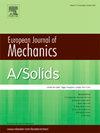On the inadequacy of a stepped-beam approach in predicting shear stresses in tapered slender solids
IF 4.4
2区 工程技术
Q1 MECHANICS
引用次数: 0
Abstract
The stress state in slender elastic cylinders with a straight axis and tapered cross-sections is investigated. Compared to the de Saint-Venant’s cylinder, the continuous variation in the dimensions of the cross-sections along the cylinder’s axis results in additional, non-trivial shear stress distributions within the cross-sections. This paper analytically investigates the dependence of these stresses on taper, a topic of significant practical interest for the design of tapered structural elements commonly employed in various engineering applications, such as components of wind turbines, aircraft, and bridges. The analytical study in this paper is based on a set of partial differential equations and boundary conditions, derived in a recent work, that govern the stress state in three-dimensional tapered cylinders undergoing cross-sectional warping, in- and out-of-plane. A new analytical solution is derived for rectangular cross-sectioned tapered cylinders, resembling the shear webs of large wind turbine blades, with external loads applied at the ends. By examining this paradigmatic case, the inadequacy of approaches based on stepped-beam models in predicting shear stresses in tapered slender solids is demonstrated analytically. Numerical examples, including comparisons to results from the literature and benchmark solutions based on finite element methods, are also provided and corroborate the analytical findings of this study.
求助全文
约1分钟内获得全文
求助全文
来源期刊
CiteScore
7.00
自引率
7.30%
发文量
275
审稿时长
48 days
期刊介绍:
The European Journal of Mechanics endash; A/Solids continues to publish articles in English in all areas of Solid Mechanics from the physical and mathematical basis to materials engineering, technological applications and methods of modern computational mechanics, both pure and applied research.

 求助内容:
求助内容: 应助结果提醒方式:
应助结果提醒方式:


